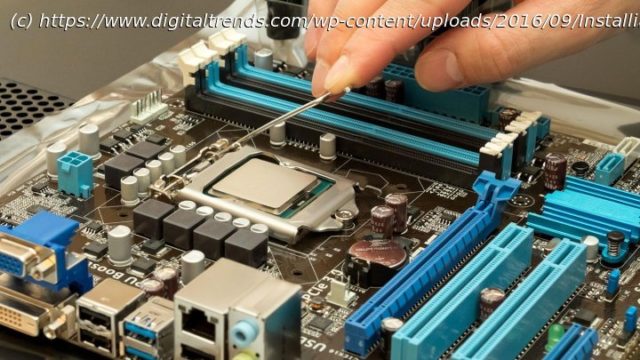Knowing how to overclock your CPU is essential for any PC enthusiast. We’ve gathered step-by-step instructions for AMD and Intel so you can overclock your CPU.
By overclocking your CPU, you can squeeze extra performance out of your PC without spending any extra money on the best processors on the market. Most processors have a little extra headroom, and if you know how to overclock your CPU, you can get extra performance for effectively nothing, helping to make your games and apps run faster. Combined with a GPU overclock, your PC could punch well above its weight.
You’ll want to make sure you have a good cooler to keep noise levels and temperatures down, but if you’re willing to take the time to learn, an overclock can be a great way to extend the life of your PC’s processor. Here’s how to do it.A word of caution
When you overclock a processor, a couple of things happen. First, the chip runs hotter and uses more power, often to the point where the efficiency is significantly worse. This is particularly problematic if you’re using a stock cooler, which typically has poor cooling capability. That doesn’t necessarily mean you can’t overclock, but your potential overclocking headroom is much lower than when using a more advanced air or liquid cooling system in your PC. Using one of the best CPU coolers will help.
Second, you’re operating outside of the limits of your CPU when overclocking, which could reduce its life span due to higher temperatures and voltage. But most moderate and even significant overclocks usually won’t impact your CPU in any meaningful way.
You’ll also have to consider the quality of your motherboard, too. Since overclocking raises power consumption, you’ll want to make sure your motherboard has enough voltage regulator modules (or VRMs) to handle it. A motherboard with poor VRMs or an insufficient amount of them will see the VRMs hit dangerous temperatures. When you’re stress-testing your PC, we recommend getting an application like HWMONITOR that can report how hot your motherboard is getting. Any component hitting 100 degrees Celsius or more can be dangerous for your PC’s health.
If you want to overclock a laptop CPU, you’re probably out of luck. Few allow it, and fewer still possess the thermal headroom to make it viable. But even if you can, we caution against it for your first overclocking venture since you might need to resort to more exotic methods, such as applying liquid metal to the CPU cooler and relying on third-party software.
Finally, overclocking your CPU can void its warranty. AMD and Intel typically don’t cover overclocking, though they would be hard-pressed to prove overclocking killed your CPU — unless you pushed way too much voltage through the chip. Similarly, motherboard manufacturers may or may not cover overclocking. If you’re concerned, check the warranty before trying.
Before you do any of that, have a good think about whether you should overclock your PC’s processor, and do as much reading about it as possible to fully inform yourself. Mistakes can prove expensive.Identify your CPU
Before you start overclocking the CPU, you’ll need to determine two things. First, whether or not your CPU can even be overclocked. This info is usually available on the manufacturer’s website (that would be AMD or Intel), but the rule of thumb is that virtually all AMD CPUs are overclockable, while only Intel CPUs ending in K or X are overclockable.
It’s pretty easy to find out which CPU your computer has.
Next, you’ll need a motherboard that supports overclocking, and it’s the chipset that matters here. AMD motherboards with the B or X prefix officially support overclocking since 2017; Intel motherboards with the Z prefix are the sole motherboards with official overclocking support. It’s not strictly impossible to overclock (or raise clock speeds) with a motherboard that doesn’t officially support it, but your options are far more limited (more on that later).
You may be wondering what kind of frequencies your CPU might be capable of hitting. Although there have been some processors that historically could overclock by up to 50%, that is an impossibility with modern designs. They’re all so well-tuned that you are unlikely to find more than a few hundred extra megahertz on even the best overclocking chips with standard cooling solutions. That doesn’t mean it isn’t worth doing, but it’s worth keeping your expectations in check. You can often achieve similar performance gains by overclocking your memory.Know what’s safe and what’s not
What’s safe for your CPU depends on what model it is and how much you’re willing to risk. For a long time, 80 to 85 degrees C was considered the hottest a CPU should get, but nowadays, CPUs like the Core i9-14900K and the Ryzen 9 7950X hit 95 degrees C right out of the box. For modern CPUs, 95 degrees C is the new limit. Of course, it’s uncertain if 95 degrees C is also safe for older CPUs that run closer to 85 degrees C at stock. For this guide, we recommend keeping temperatures at least under 95 degrees C, though less than 85 degrees C is ideal.
Make sure you’re familiar with how to check your CPU’s temperature.
In order to give your PC the best possible thermal performance, we recommend taking a can of compressed air and a cloth to clean all the dust out of your PC while wearing an antistatic bracelet. Don’t use a vacuum, it can create dangerous static electricity, in addition to not being very good at cleaning out dust from filters, fans, and coolers. You may also decide to give your CPU fresh thermal paste or even get a brand-new cooler.
Voltage depends on two factors of your CPU: its model and its quality. The vast majority of CPUs from a specific generation will have a similarly safe limit for voltage, regardless of chip quality. In the table above, we have provided estimates for what kind of voltage you need to achieve an overclock within the corresponding frequency range, but you shouldn’t assume your CPU is safe just because it’s at or under that amount of voltage. We stress that it’s hard to foresee the long-term consequences of raising the voltage on any CPU.
Furthermore, some CPUs have a higher quality than others and can reach higher clock speeds at lower voltages, which is why there’s a range of frequencies rather than a single number. Higher voltage will almost always increase a processor’s ability to hit higher frequencies, but since you can’t increase the voltage indefinitely without damaging or killing your CPU, having a higher-quality CPU will make a big difference.
You might wonder why temperatures rise so much after overclocking. Well, voltage directly impacts power consumption in the same way that increasing the voltage increases power consumption. Power consumption is what makes a processor hot, which is why higher-end CPUs with more power draw need bigger coolers. Increasing the clock speed will also increase power, and since you’ll be increasing both the voltage and clock speed to overclock, you will likely see a dramatic rise in power.Intel CPU: Extreme Tuning Utility
Since this is a beginner’s guide to overclocking, we’re going to start off with Intel’s Windows-based Extreme Tuning Utility (XTU). It’s a free software suite explicitly designed to overclock your Intel CPU. The main advantages of XTU are that it’s official, has tons of settings to tweak, and gives useful statistical information. Even if you’re not overclocking, it’s a great little utility providing loads of information about your system.
XTU isn’t a perfect program, but it is a good gateway into overclocking, even though it can look intimidating at first with its many options. However, you really only need to worry about a few things and most of these options can be safely ignored.
Step 1: The first time you start XTU, take a few baseline readings to make sure your CPU is ready to overclock. Start by running Stress Test located on the left-hand menu. Run this test for at least an hour.
You can sit and watch the test or do something else. If you leave, return toward the end of the hour and look at the system information in the window’s base. Take note of the Package Temperature. If your CPU is hotter than 85 degrees C, you don’t have much, if any, thermal headroom to overclock. We recommend improving your cooling before continuing any further.
If your temperature is below that — preferably well below — you have some thermal wiggle room to push your chip at a higher frequency (with relative safety).
Step 2: Although you can overclock your CPU using the Basic tab, learning about the different components of an overclock will help you better understand what’s happening with the chip. It also makes it easier to achieve a stable overclock. Select the Advanced Tuning tab from the left-hand menu and then look at the section called Multipliers.
Multipliers (or CPU ratios) correspond to the speed you’re getting out of the CPU. It’s a multiplication of the BCLK frequency, or base clock, which by default is 100MHz. A x32 multiplier would typically mean a turbo frequency of 3.2GHz. Raise your multiplier by one number (x33 in our example) across all cores. Although you can adjust frequencies individually on different cores, we’ll push for an all-core overclock to keep things simple.
Step 3: Now, test the overclock’s stability.






